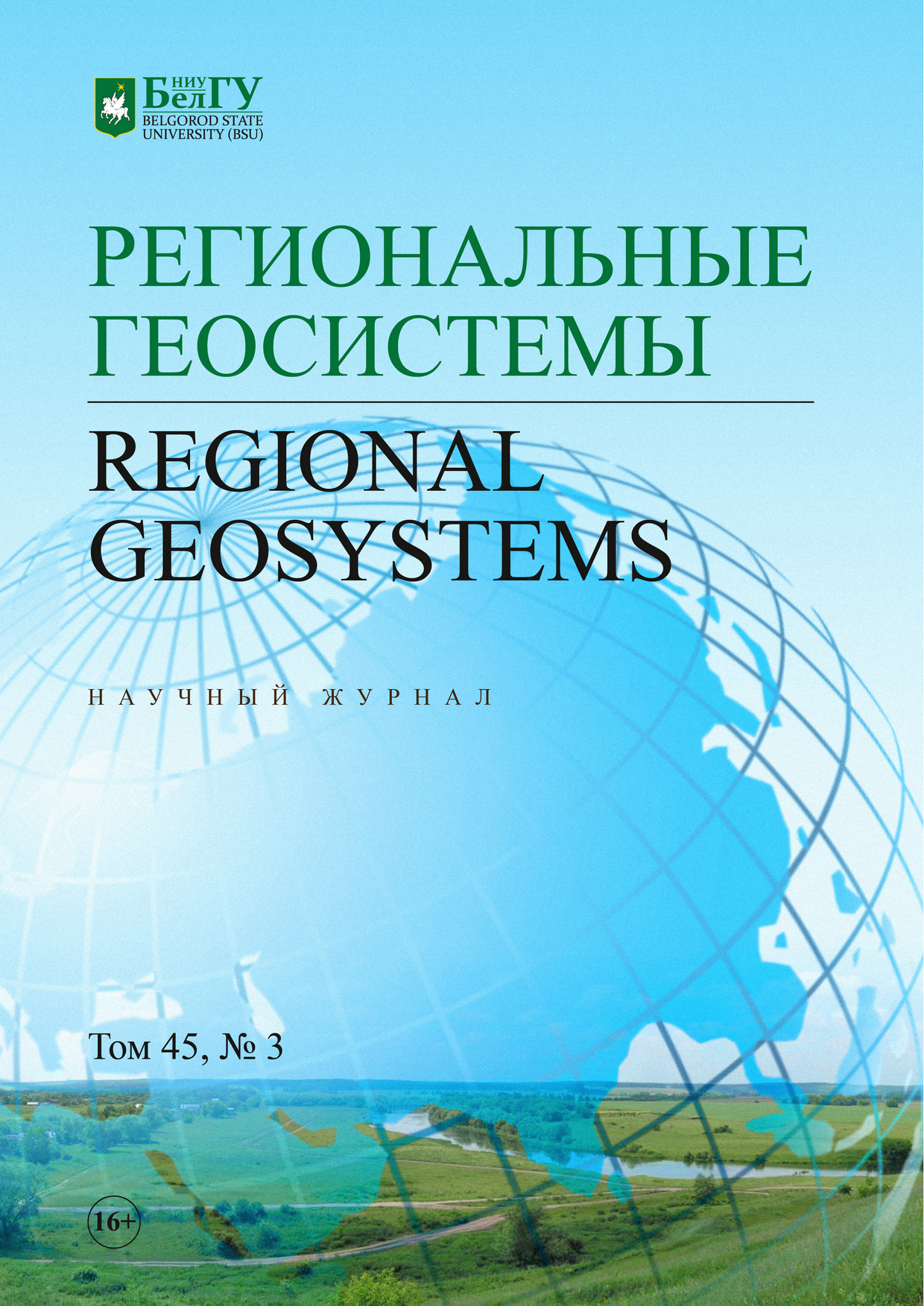Assessment of the landscape and aesthetic attractiveness of suburban forests of the Cheboksary city
DOI:
https://doi.org/10.52575/2712-7443-2021-45-3-288-300Keywords:
suburban forests, forest sustainability, landscape and aesthetic assessment, forest health, aesthetic value of forest landscapesAbstract
The population of Cheboksary uses recreational areas that are convenient from the point of view of transport accessibility for recreation, neglecting slightly distant stable, aesthetically attractive forests. The study was conducted to inform the population about the state of forests in order to evenly distribute the recreational load. The assessment was carried out according to 5 indicators: the value of the prevailing breed, the variety of plant species in the undergrowth, the age group for the prevailing breeds, the score, the clutteriness of the forest area and dead wood, and the sanitary and hygienic assessment. In total, 1168 forest allotments of the Karachurinsky, Sosnovsky and Pihtulinsky district forest districts of the Chuvash Republic were analyzed. A summary map of the landscape and aesthetic assessment of forests was compiled and recommendations were developed to improve the aesthetic appeal of tree stands. For suburban tree stands of Cheboksary, the landscape and ecological assessment of the vast majority of forests is characterized by above average. Low aesthetic evaluation is characterized by plantings in a state of decay, which have lost their decorative qualities due to mechanical damage, over-aging, or infestation with pests and diseases. The implementation of the obtained results allows us to optimally distribute the load on suburban forests. The novelty of the study lies in the landscape approach to the allocation of optimal recreational areas.
Downloads
References
Аратова Д.З. 2019. Экологическое значение насаждений в условиях города Уфы. Российский электронный научный журнал, 1 (31): 96–102. DOI: 10.31563/2308-9644-2019-31-1-96-102.
Гизатуллина Г.И. 2018. Лесоводственно-экологическая характеристика насаждений общего пользования в г. Уфе. Дис. ... канд. с.х. наук. Уфа, 161 с.
Гуменюк А.Е., Мулендеева А.В., Никитина А.С. 2019. Использование аттрактивности побережий Чебоксарского водохранилища в территориальном развитии региона. В кн.: Современные проблемы водохранилищ и их водосборов. Труды VII Всероссийской научно-практической конференции с международным участием. Пермь, 30 мая – 02 июня 2019 г. Пермь, Пермский государственный национальный исследовательский университет: 69–76.
Ильин В.Н., Никонорова И.В. 2017. Выбор оптимальной территориальной единицы для планирования экологического каркаса интенсивно освоенных регионов лесостепной зоны (на примере Чувашской Республики). В кн.: Охрана природы и региональное развитие: гармония и конфликты (к Году экологии в России). Материалы международной научно-практической конференции. п. Партизанский Бузулукского района Оренбургской области, 01–05 октября 2017 г. Оренбург, Институт степи Уральского отделения Российской академии наук: 282–285.
Ильин В.Н., Орлов П.С. 2020. Пути оптимизации земельного фонда Чувашской Республики на основе анализа соотношения угодий. В кн.: Науки о Земле: от теории к практике (Арчиковские чтения – 2020). Материалы Всероссийской научно-практической конференции. Чебоксары, 05–08 ноября 2020 г. Чебоксары, Новое время: 356–359.
Ковязин В.Ф., Нгуен Тхи Тхюи. 2017. Комплексная оценка лесных насаждений Санкт-Петербура. В кн.: Биодиагностика состояния природных и природно-техногенных систем. Материалы ХV Всероссийской научно-практической конференции. Киров, 04–06 декабря 2017 г. Киров, Вятский государственный университет: 157–160.
Нешатаева Е.В., Ковязин В.Ф. 2013. Лесоводственные характеристики городских лесов Санкт-Петербурга. Астраханский вестник экологического образования, 4 (26): 131–138.
Никитина А.С., Мулендеева А.В. 2017. Комплексный анализ лесного фонда Чебоксарского городского округа. В кн.: Науки о Земле: от теории к практике (Арчиковские чтения – 2017). Материалы Всероссийской молодежной школы-конференции. Чебоксары, 21–23 ноября 2017 г. Чебоксары, Среда: 243–250.
Репшас Э. 1994. Оптимизация рекреационного лесопользования (на примере Литвы). М., Наука, 240 c.
Тарасова О.Ю., Москалева С.А., Васин С.Н. 2016. Анализ нарушений использования земель лесного фонда ГКУ РМ "Виндрейское территориальное лесничество" в Республике Мордовия. Научное обозрение. Международный научно-практический журнал, 1: 7.
Ciesielski M., Stereńczak K. 2018. What do we expect from forests? The European view of public demands. Journal of Environmental Management, 209: 139–151. DOI: 10.1016/j.jenvman.2017.12.032.
Ebenberger M., Arnberger A. 2019. Exploring visual preferences for structural attributes of urban forest stands for restoration and heat relief. Urban Forestry & Urban Greening, 41: 272–282. DOI: 10.1016/j.ufug.2019.04.011.
Gao Y., Zhang T., Sasaki K., Uehara M., Jin Y., Qin L. 2021. The spatial cognition of a forest landscape and its relationship with tourist viewing intention in different walking passage stages. Urban Forestry & Urban Greening, 58: 126975. DOI: 10.1016/j.ufug.2020.126975.
Konashova S.I., Sultanova R.R., Khairetdinov A.F., Gabdrakhimov K.M., Konovalov V.F., Rakhmatullin Z.Z., Isyanyulova R.R., Nasyrova E.R., Gubaidullin A.F., Muftakhova S.I. 2018. Forestry and ecological aspects of the broad-leaven forest formation. Journal of Engineering and Applied Sciences, 13 (S11): 8789–8795. DOI: 10.3923/jeasci.2018.8789.8795.
Miller A.B., Kays R., Leung Y.F.2020. Wildlife response to recreational trail building: An experimental method and Appalachian case study. Journal for Nature Conservation, 56: 125815. DOI: 10.1016/j.jnc.2020.125815.
Oku H., Fukamachi K. 2006. The differences in scenic perception of forest visitors through their attributes and recreational activity. Landscape and Urban Planning, 75 (1–2): 34–42. DOI: 10.1016/j.landurbplan.2004.10.008.
Oppliger J., Lieberherr E., Hegetschweiler K.T. 2019. Factors influencing teenagers’ recreational forest use in a densely-populated region in Switzerland. Journal of Outdoor Recreation and Tourism, 27: 100225. DOI: 10.1016/j.jort.2019.100225.
Pirnat J. 2000. Conservation and management of forest patches and corridors in suburban landscapes. Landscape and Urban Planning, 52 (2–3): 135–143. DOI: 10.1016/S0169-2046(00)00128-6.
Vakhlamova T., Rusterholz H.P., Kamkin V., Baur B. 2016. Recreational use of urban and suburban forests affects plant diversity in a Western Siberian city. Urban Forestry & Urban Greening, 17: 92–103. DOI: 10.1016/j.ufug.2016.03.009.
Yang Y. 2017. The Practice and Exploration of Shanghai Recreational Trail System Planning. Procedia Engineering, 198: 127–138. DOI: 10.1016/j.proeng.2017.07.077.
Abstract views: 254
Share
Published
How to Cite
Issue
Section
Copyright (c) 2021 REGIONAL GEOSYSTEMS

This work is licensed under a Creative Commons Attribution 4.0 International License.


